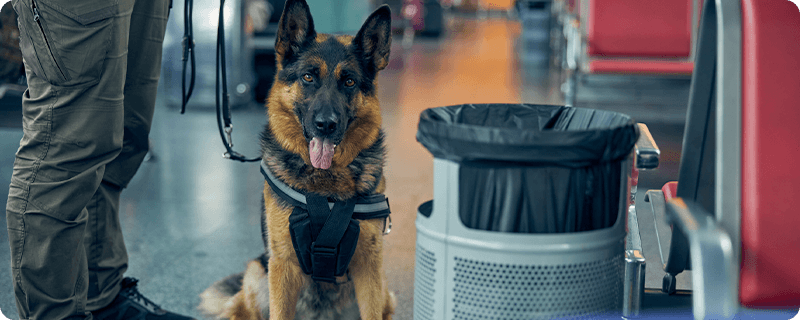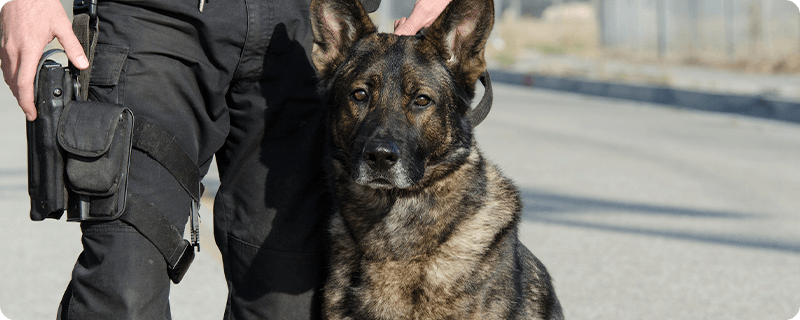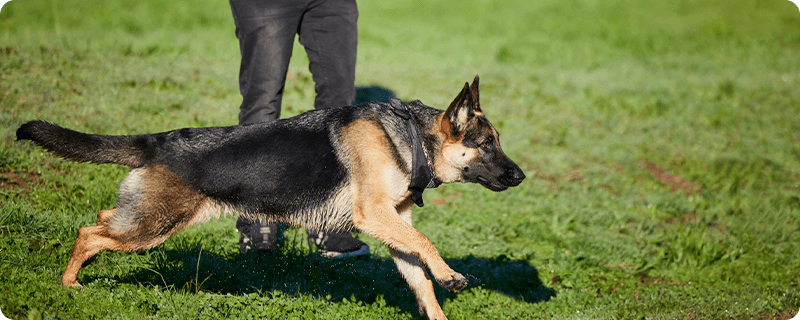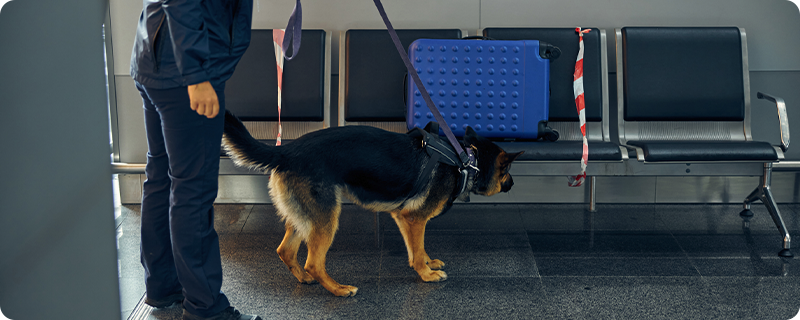7 Critical Canine Security Questions to Ask (for School and Hospital Administrators)
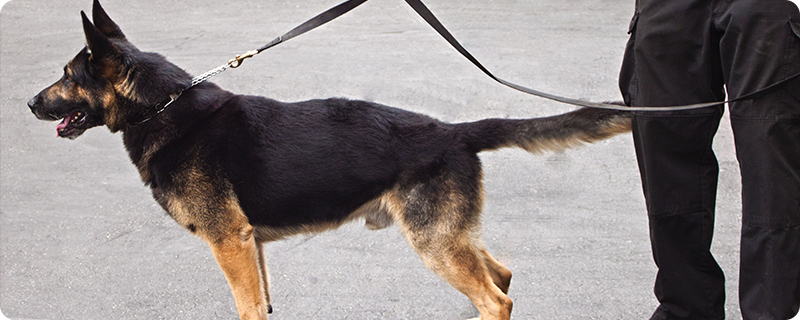
Workplace violence is on the rise and canine security teams add an additional resource to reduce this.
7 Critical Canine Security Questions to Ask (for School and Hospital Administrators)
HCPro reported an interesting story that took place in Southern California. Two opposing gangs came into the lobby of a hospital; both gangs were upset and started fighting each other. The gangs started hollering at each other in the lobby area, which prompted calling the canine security team. The dispatcher of the hospital called the canine security team. Within thirty seconds, “you could hear a pin drop.” This is an example of how canine security can reduce (or eliminate) a potentially violent situation when a canine is presented to aggressive or noncompliant individuals.
Workplace violence is on the rise
According to OSHA’s Workplace Violence in Healthcare report, “From 2002 to 2013, incidents of serious workplace violence (those requiring days off for the injured worker to recuperate) were four times more common in healthcare than in private industry on average.”
And OSHA’s website indicates that “[i]n 2011, U.S. hospitals recorded 253,700 work-related injuries and illnesses, a rate of 6.8 work-related injuries and illnesses for every 100 full-time employees. This is almost twice the rate for private industry as a whole.”
Canine security teams: an additional solution to reduce workplace violence Canine security can replace traditional security measures and equipment, but it doesn’t have to; it can be used as an additional layer of security. From the National Center for Biotechnology Information website, canines have effectively reduced crime and violence by 75 percent to 80 percent in Midwest and East Coast hospitals. And from the K9Fleck.org website, “a second study in Yarmouth, MA showed a dramatic 80% decrease in commercial break-ins following the first year of a canine unit being on patrol and aggressively addressing the issue of the break-ins.
Here’s the secret to why canines are so effective: the intruder (instead of the staff or patients) becomes the prey. If you’re a hospital or school administrator worried about security risks, canine security teams are another way to increase protection for your organization.
With so much uncertainty in the world today, how do you know if a canine security team is right for your organization?
Over the past few months, people have been asking me the same questions about canine security teams. I’ve decided to tackle the seven most common questions here to help you decide whether canine security teams can provide an additional layer of security for your organization.
7 Critical Canine Security Team Questions to Ask (for School and Hospital Administrators)
1. Why hire a canine security team?
Dogs are a visual deterrent
Often, just the presence of a dog can deter someone from acting unlawfully or dangerously. Dogs can deter aggressive behavior by their presence and their bark. They can even help maintain order and keep a friendly atmosphere during business hours and activities.
Administrators might be wondering about the liability of dogs biting people. The simple answer is these canines won’t bite unless it’s a life-threatening situation. The canines used in schools and hospitals are raised and trained to be both people-friendly and to go into defense mode as the need arises.
Response time: canines vs. police
Consider these statistics:
- As of 2013, the reported national average for police response time was 11 minutes.
- An in-house K9 security unit can greatly reduce or eliminate the typical response times of 30-45 minutes from State Police (if the unit is on duty when deployed).
This kind of security is unquestionably priceless.
Canine security teams engage perpetrators immediately—while everyone is waiting for the police to arrive. This gives everyone a few extra seconds or even minutes to escape a dangerous situation.
Speed of dogs
Canine security dogs can run up to 30 mph. Why is speed an important factor? Because the perpetrator is dealing with lots of psychological factors in the heat of the moment, a fast-moving dog is extremely difficult for a perpetrator to target accurately. Canines don’t have this barrier. Remember, the dog is naturally focused on anything or anyone moving.
For decades, dogs have been used in combat to help protect our military personnel in dangerous and life-threatening situations. In most cases, the dog will prevail; it’s in its DNA to accomplish its goal—to make sure it defeats the perpetrator.
Wide variety of places
Security directors and administrators are looking for additional security solutions because the standard protocols aren’t working. Security canines can cover a large space quickly due to their speed and mobility. In fact, one canine can cover as much territory as four to five security guards. Metal detectors, surveillance systems, and the like are great, but they’re passive—meaning, someone who has a gun and is intent on using it will use it. Now it’s down to a matter of seconds . . . what will happen? How are we going to counteract the threat? What will people do? How does that issue get addressed? Canines are a positive alternative. For instance, security canines are trained to detect gunpowder. If someone at a school or hospital has a concealed gun, the canine will alert the canine handler. When the canine alerts the handler, the handler can command the canine to attack the perpetrator.
A security measure that works
Trained security canines are more effective than people or machines because of their senses of smell and hearing. They can detect strange sounds, noises, and unusual odors. When a trained security canine hears or smells gunfire, it can detect more accurately than humans from where the gunfire originated.
Additionally, compared with bomb-detecting robots, dogs are mobile. Surveillance cameras, on the other hand, are stationary, limiting their range of view and the type of activity captured. In 2010, after spending six years and $19 billion on research to develop better bomb-detecting technology, Pentagon officials admitted that dogs’ noses were still superior to their most sophisticated technology. (Source: New Atlas)
2. Are security canines safe to be around?
One out of every 10 dogs will pass the test needed to work in a variety of social environments. They must be able to be petted by a wide range of people and not react aggressively, but must also be ready to go into defensive mode when the situation warrants. These are not your typical police dogs, which tend to be less social. A trained canine will always turn to its handler/family for command and control before reacting. A confident dog will chase and attack only on command or if he or his handler is physically attacked first. A confident dog is never frenzied and can be called off immediately and without question.
Quality, trained security dogs can easily be integrated into businesses, schools and hospitals. They can also be public relations agents within the community, which changes perceived negative experiences to heartwarming experiences.
3. What are the characteristics of a properly trained canine security team?
Here are a few critical factors to consider when selecting a canine security team for your business, hospital or school:
A canine security team consists of two elements:
- The canine
- The handler
Each element has its own characteristics, so let’s look at each separately. Key characteristics of a properly trained security canine:
- Pleasant disposition: the dog’s true nature (i.e., tendencies it was born with)
- Readiness to obey and act appropriately in all environments
- Self-assurance: they can’t be cowards
- Vigilant: highly perceptive and aware of their surroundings
Key characteristics of a properly trained canine handler:
- Understands the client’s perspective
- Sound reputation
- Sound decision maker
- Team player
- Addresses both big and small issues
- Excellent communicator
4. Is canine security service cost-efficient?
Think about cost efficiency this way . One canine team (one canine plus one handler) can provide the same coverage as five security guards. That means a canine security team is more cost-efficient than traditional security guards because:
- You’re paying for fewer people.
- You’re paying lower insurance premiums for canines versus armed guards.
- You lower your liability (in the short and long terms).
- Your return on investment is higher because a canine security team—versus an armed or unarmed security guard—can cover more ground, deter and apprehend the perpetrator, and be a visual deterrent for everyday security issues.
5. Can canine security teams work eight-hour (and overtime) shifts?
Yes. Canine security teams can easily work eight-hour shifts because they are doing what comes naturally to them. This comes from their heritage as being farm dogs and protecting the herd and the farmer. German shepherds and Belgian Malinois take power naps just as humans take lunch and other breaks during an eight-hour shift, but they are always ready to go into action when the need arises.
6. Why are canine security teams better than most armed guards?
Canine security teams are better than most armed guards because they will go after perpetrators without hesitation. In highly stressful situations, armed guards might hesitate to act appropriately, or they might get confused by having too many conflicting thoughts, thereby not focusing on stopping the perpetrator. Or, worse, they might shoot someone who is innocent. In addition, security canines get praised for going after perpetrators; to them, it’s a positive experience.
7. Do staff and employees like security canine teams in their workplace?
First, staff feels more secure when they see a protection dog.
“They have a nice presence,” said Donna Disney, RN, BSN, CEN, Mercy’s clinical director for the ED. “Anytime we have a situation that is escalating, the added presence of the dogs helps people get themselves together. They see it as another level of authority.”
“It gives us peace of mind,” Disney added. “It’s interesting to see the effect when you have a really busy waiting room. The dogs tend to calm everybody down. It’s a distraction as much as anything, [to] watch the dog for a minute. We joke and call them our favorite security officers.”
Staff members also experience and feel an extra level of safety while on the job. These dogs have a special temperament that enables them to deal with the public 24 hours a day. The dogs K9 X-Factor uses have been tested in all capacities and have nerves of steel. Our canines can be trusted with children and are never bullying or dominant. They have nothing to prove because they know they can handle any security situation that may arise. You can rely on these dogs to keep you safe.
Summary
Should we look at alternative, nonlethal ways to prevent crime? Or are guns the only preventive measure? As a security consultant for the past 15 years, I can tell you with certainty . . . there is a better way. I’ll leave you with this thought: I tell people I can recall a dog, but I can’t recall a bullet.
Next step
Mark Bosque is a security consultant and owner of K9 X-Factor. His company can reduce hospital and school security concerns with canine security teams. K9 X-Factor partners with hospitals and schools seeking an alternative approach to protecting their employees while reducing expensive liability issues related to having armed security guards. K9 X-Factor is unique because your hospital or school gets “friendly first” dogs without sacrificing patients’, students’ and employees’ safety. Other canine security companies use dogs that are rewarded to go after a threat. While that can be useful in dangerous situations, those dogs lack the social temperament to be people-friendly.
K9 X-Factor dogs are friendly with all people—including children and seniors—and are trained to address threats instantly. Whether you want to buy a canine or lease a security canine team from K9 X-Factor, message me to see if a canine security team is right for you.

